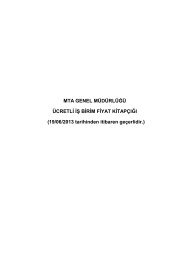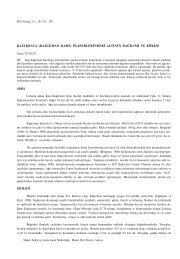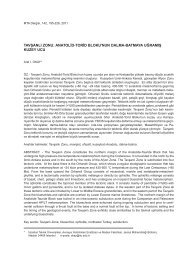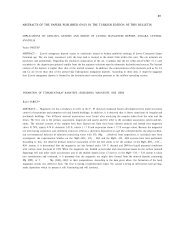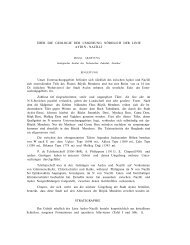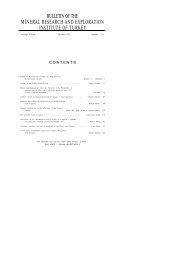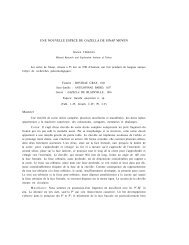full text, PDF - MTA
full text, PDF - MTA
full text, PDF - MTA
Create successful ePaper yourself
Turn your PDF publications into a flip-book with our unique Google optimized e-Paper software.
Mineral Res. Expl. Bull., 137, 29-48, 2008<br />
THE MINERALOGIC, PETROGRAPHIC AND ION EXCHANGE CAPACITY FEATURES<br />
OF TUFFS CONTAINING CHABAZITE AND PHILLIPSITE MINERALS IN SANDIKLI<br />
(AFYON) REGION AND THEIR USAGE IN AGRICULTURE (SOUTHWEST<br />
ANATOLIA, TURKEY)<br />
Yahya ÖZPINAR*<br />
ABSTRACT.- The study area is located at southern part of Sandýklý town (Afyon-southwest Anatolia). The volcanics<br />
of Sandýklý region in the investigated area are represented by lavas and pyroclastic rocks of Middle-Late<br />
Miocene age. The Lavas occur as trachyandesitic, phonolitic tephritic, basaltic andesitic, basaltic trachy-nephelinitic,<br />
andesitic and dacitic in compositions. Pyroclastic rocks are composed of lapillistone, tuffaceous conglomerate,<br />
tuffaceous sandstone, tuffacous siltstone and tuffaceous mudstone, and also have vitric and crystal vitric<br />
tuffs in thrachyandesitic, phonolitic and tephritic compositons. In the tuffs located at the northern part of the<br />
investigated area the chabazite occurences, and in the tuffs located at the southern part the phillipsite occurences<br />
are found widespreadly. In phillipsitic tuffs, three-phillipsite forms were defined namely potassium-sodium-aluminum-silicate<br />
hydrate, sodium-aluminum-silicate hydrate and potassium-calcium-aluminum-silicate hydrate<br />
froms. In tuff samples purified with tetrabrom ethane the zeolite contents by weight mostly between 29.00 wt.%<br />
and 63.00 wt.%. After the activition of the tuff samples with 0.1N HCl and 0.1N H2SO4, their cation exchange features<br />
were investigated. In the tuffs activated with both acids, Ca +2 content with respect to other cation contents<br />
has been passed too much to the solutions depending on time. But those activated with 0.1N HCl, as depending<br />
on time, Ca +2 content has been passed as more linear to the solutions. When we consider of ion exchange capacity<br />
and selection of the radioactive cations such as 137 Cs and 90 Sr and 40 K of chabazite and phillipsite, zeolitic tuffs<br />
may be used for improvement of soil, stabilization of pH of acidic soils and to prevent to passing of the radioactive<br />
elements from nature to the environment and biological systems. Because of activated natural zeolites tend<br />
to the increasing of the resorption and adsorption of moisture which contributes to the plant development, activated<br />
natural zeolitic tuffs may be used as desiccants. For the adsorption of the ammonium smells arised from urine<br />
and fecal matter, it is thought that zeolitic tuffs may be used to separate methane from other gasses. Besides, it<br />
is believed that it is possible to use them as building stone for heating and air conditioner for small houses and<br />
animal shelters.<br />
Keywords: Chabazitic and phillipsitic tuffs, Sandýklý, Southwest Anatolia.<br />
INTRODUCTION<br />
The investigated area is located at southern<br />
part of Sandýklý town. The Sandýklý is the town of<br />
Afyon city and situated at the western part of<br />
Central Anatolia in Turkey (Figure 1). This study<br />
comprises part of investigations supported by<br />
TUBITAK "YDABÇAÐ-198Y102". In this project,<br />
geological, petrographical and mineralogical features<br />
of Sandýklý volcanics were investigated and<br />
experiments were made to determine technologic<br />
usage of tuff and tuffites. However the purpose<br />
of this paper is to report the results of detailed<br />
Figure 1- Location map of the study area.<br />
*Pamukkale Üniversitesi, Mühendislik Fakültesi, Jeoloji Müh. Bölümü, Kýnýklý Kampüsü, 20017, Denizli.
30<br />
study of mineralogic, petrographic and ion exchange<br />
capacity features of tuffs containing of<br />
chabazite and phillipsite minerals at southern<br />
part of Sandýklý town and their evaluation for<br />
healthing.<br />
The investigated area and its surrounding districts<br />
have been studied by many investigators<br />
based on investigation topics. Some of these<br />
studies can be grouped as following. The Afyon<br />
and Sandýklý Neogene basins and hydrogeological<br />
feature of Hüdai geothermal area in Sandýklý<br />
region have been studied by Ronner (1962), Bulutcu<br />
(1975) and Afþin (1991) and they pointed<br />
out that the Hüdai geothermal water have high<br />
radioactive features. The geological and petrological<br />
features of Afyon and Sandýklý volcanics<br />
of Middle and Late Miocene age, namely trachyte,<br />
thrachyandesite, rhyolite, latite and basalt<br />
having alkaline and calk-alkaline character have<br />
been studied by Villari and Keller (1972), Keller<br />
(1983), Öngür (1973), Baþarýr and Kun (1982)<br />
and Ercan( 1986). Using the K-Ar age method, of<br />
the Sandýklý volcanics have been dated by<br />
Besang et al. (1977) and obtained the ages<br />
14±0.3- to 8.0±0.6 Ma. Çoban and Flower (2007)<br />
asserted that the magmatism in the Kýrka-Afyon-<br />
Isparta region shows a temporal progression<br />
from calk-alcaline to ultrapotassic affinity which is<br />
associated with the geodynamic evolution of the<br />
"Isparta Angle". The petrological evolution and<br />
lamprophyres of Afyon stratovolcano have been<br />
investigated by Aydar et al. (1996, 2003). Tectonic<br />
and metamorphic evolutions of Sandýklý-<br />
Afyon region have been studied by Öngür (1973)<br />
and Tolluoðlu et al. (1997). Zeolitization in Sandýklý<br />
tuffs, firstly has been discovered by author<br />
(Özpýnar, 1998; Özpýnar et al. 1998). In addition,<br />
Özpýnar et al. (2002) studied petrographic and<br />
petrochemical features of zeolitic tuffs at southern<br />
part of Sandýklý region.<br />
METHOD OF STUDY<br />
In this study, for determining the distribution of<br />
Sandýklý volcanics, detailed mapping of an area<br />
Yahya ÖZPINAR<br />
about 180 km 2 was firstly done at 1/25 000 scale<br />
and microscopic studies of 98 samples were carried<br />
out. Later, for all study 101 samples of lavas,<br />
tuffs and tuffites were qualitatively determined by<br />
XRD and zeolites specimens purified with heavy<br />
liquid (tetrabrom ethane) qualitatively determined<br />
by DTA (10 sample) and electron microscope (8<br />
sample) and chemical analyses of the altered<br />
lavas, tuffs and tuffits (58 sample) were carried<br />
out by XRF in R&D laboratories of Turkish Cement<br />
Manufacturer's Association. In addition the<br />
chemical analyses of the lavas (8 sample) and<br />
tuffs (2 samples) were carried out by ICP-MS in<br />
Acme Analytical Laboratories Ltd., Canada. Beside,<br />
cation exchange capacity tests were carried<br />
out by flame photometry (JENWAY mark) apparatus<br />
in laboratory geological engineering department<br />
of Pamukkale University.<br />
STRATIGRAPHY AND PETROGRAPHY<br />
In the study area the Karatepe formation represented<br />
by violet colored conglomerate and siltstone<br />
of Late Triassic-Early Jurassic age is exposed<br />
at the bottom of the sequence and well<br />
observed southwest of Yeniçay located at the<br />
western part of the area (Figure 2). The Karatepe<br />
formation is transitionaly overlain by Derealaný<br />
formation of Jurasssic age which is also transitionaly<br />
overlain by Akdað formation of Late Jurassic-<br />
Early Cretaceous age exposed at the<br />
mountainous areas of the southern and southeastern<br />
part of Sandýklý region. From lower to upper<br />
parts, the Akdag formation is represented by<br />
gray and dark gray colored micritic and cherty<br />
limestones, respectively.<br />
The Akdað Formation is unconformably overlain<br />
by Neogene age units. Lacustrine detritic<br />
rocks of Middle(?)-Late Miocene age is located<br />
at the lower part of lithologic units and composed<br />
of conglomerate, sandstone, marl and<br />
limestone. This unite is unconformably overlain<br />
by the detritic rocks of Quaternary represented<br />
by gravel, sand and clay (Figure 2 and 3).
Figure 2- Geological map of the study area.<br />
In the study area, the Middle-Late Miocene<br />
volcanics and volcano-sedimentary units have<br />
been named as Sandýklý volcanics. By using the<br />
radiometric age method, the age of Sandýklý<br />
Lavas have been dated by Besang et al. (1977)<br />
and the ages obtained range between 14±0.3 -<br />
8.0±0.6 Ma (Ercan, 1986). The Sandýklý volcanics<br />
are mainly composed of red, gray and light<br />
brown colored lavas and pyroclastic rocks ( Figure<br />
2 and 3).<br />
The pyroclastic rocks have various ratio of<br />
pyroclastites, epiclastites (Schmidt, 1981), pyrogenetic<br />
and secondary minerals. The pyroclastic<br />
CHABAZITE AND PHILLIPSITIC TUFFS, SANDIKLI 31<br />
rocks are named as lapillistone, tuffaceous conglomerate,<br />
tuffaceous sandstone, tuffaceous siltstone<br />
and tuffaceous mudstone. The coarse<br />
grained pyroclastic rocks are found at lower part<br />
of the sequence. At bottom, lapilli could become<br />
thrachyandesitic rock pieces and also could become<br />
white and gray colored pumice pieces (Figure<br />
4). The matrix generally comprises fine and<br />
coarse grained volcanic ash. Above these rocks<br />
the tuffaceous sandstone overlies which contains<br />
few sand sized epiclasts and at the upper leves<br />
of sequence the tuffaceous mudstone is present<br />
(Schmidt, 1981; Fisher and Schmincke, 1984).
32<br />
Tuffs are exposed at southern and northern<br />
parts of investigated area. They have thrachyandesitic,<br />
phonolitic and tephritic compositons (Özpýnar,<br />
2001; Özpýnar et al., 2002) named as vitric<br />
tuff and crystal vitric tuff. As depending on zeolite<br />
type (chabazite and phillipsite), zeolitic tuffs indicate<br />
different <strong>text</strong>ural and structural features.<br />
Chabazitic tuffs have cream colored, consolidated<br />
components and contain high porosity<br />
which are exposed at northern part of investigated<br />
area (south and west of Selçik village). According<br />
to identification by optical microscope, they<br />
Yahya ÖZPINAR<br />
Figure 3- The simplified schematic columnar section of the study area,<br />
(not to scale).<br />
have pyroclasts and epiclast in various ratio and<br />
sizes. In the tuffs, pyroclasts have microlitic and<br />
micro-porphyric <strong>text</strong>ure. In the pyroclasts, plagioclase<br />
and augite are found as microlite and phenocrystalls.<br />
As a result, cream colored tuffs contain<br />
sanidine, albite, augite, biotite, clay minerals<br />
(illite), zeolite (chabazite) chlorite, opaque minerals<br />
and iron oxide. These minerals have also<br />
been determined by X-ray diffractometer.<br />
Phillipsitic tuffs are gray, dark gray and brownish<br />
in color and have extremely consolidated<br />
components and high specific density than cha-
CHABAZITE AND PHILLIPSITIC TUFFS, SANDIKLI 33<br />
Figure 4- Field views from pyroclastic rocks. A, B and C) Tuffaceous conglomerate, tuffaceous<br />
sandstone, tuffaceous siltstone and tuffaceous mudstone. D) Tuffaceous lapillistone with<br />
rhyodacitic pumice E) Cream colored tuffs located at northern part of study area and<br />
F) Dark gray and brownrish colored tuffs located at southern part of study area.
34<br />
bazitic tuffs. These are exposed at southern part<br />
of study area and located at Ballýk, Ömerkuyu<br />
and Soðucak village, Sütlüce Küfeke tepe and its<br />
surrounding area. In the gray, dark gray and<br />
brownish tuffs, pyroclasts have microlitic and<br />
porphyritic <strong>text</strong>ure. In addition, they have fine<br />
gravel and coarse sand sized and reworked and<br />
partly rounded. Beside, the tuffs contain a few<br />
radiolarite fragments which are partly rounded.<br />
The Soðucak tuffs have fine gravel and coarse<br />
sand sized particles of basaltic and trachybasaltic<br />
compositions and Fe-oxide alteration is<br />
commonly seen. In Sütlüce Kufeke hill area, tuffs<br />
present columnar structure and they have lesser<br />
Yahya ÖZPINAR<br />
pyrogenic minerals and contain partly microcrystalline<br />
limestone "micrite" (Folk, 1962). The pumice<br />
contents are too much. According to the<br />
identification by optical microscope, the phillipsitic<br />
tuffs contain plagioclase (albite), augite, zeolite<br />
(phillipsite), biotite, clorite, calcite and iron<br />
oxide (Figure 5 and 6). These minerals have also<br />
been determined by X-ray difractograms. In gray,<br />
dark gray and brownish tuffs, three phillipsite<br />
form were determined. These are potassiumsodium-aluminum-silicate<br />
hydrate, potasium-aluminum-silicate<br />
hydrate and potassium-calciumaluminum-silicate<br />
hydrate.<br />
Figure 5- Microscopic views of vitric and crystal tuff (A), zeolitization of in pyroclasts and glassy<br />
matrix (B). Microscopic views at single (on the left) and double nicol (on the right) prism<br />
(A: 40X. B: 100X)
CHABAZITE AND PHILLIPSITIC TUFFS, SANDIKLI 35<br />
Figure 6- Thin section views of zeolitic tuffs. Zeolites have been seen with pseudo-hexagonal and<br />
isometric dodecahedron forms, under the microscope (A and B), large grain zeolite minerals<br />
(C) microscopic views from single (on the left) and double nicol (on the right) prism<br />
(100X)
36<br />
In these area, phillipsites genarally have K,<br />
Na- form and K-form and besides K, Ca-form is<br />
lesser than the other form. In these tuffs, zeolitization<br />
of Soðucak location is too much and at<br />
some locations, ratio of zeolitization approach to<br />
80% and 85%.<br />
Sandýklý lavas have trachyandesitic, phonolitic<br />
tephritic, basaltic andesitic, basaltic trachynephelinitic,<br />
andesitic and dacitic compositions<br />
(Özpýnar , 2001., Özpýnar et al., 2002), mineralogic<br />
composition and <strong>text</strong>ural features of andesite<br />
and trachyandesite specimens is essentially<br />
pilotaxitic, hyalopilitic, hyalo-porphyritic and<br />
micro-porphyritic. Groundmass essentially consists<br />
of fine and medium sized plagioclase microlites<br />
in a glassy matrix. Sanidine, plagioclase (oligoclase),<br />
biotite, basaltic hornblende occur as<br />
phenocrysts. The sanidine phenocrysts determined<br />
in the samples have very large sizes (from<br />
3 to 5 cm). Apatite, sphene and zircon can be<br />
observed as accessory minerals. The chlorite<br />
and calcites have been found as secondary minerals.<br />
The results of microscopic and X-ray diffractograms<br />
are similar. Quartz, albite, sanidine,<br />
orthoclase, augite, biotite and illite from the mineralogic<br />
compositon of the samples in general.<br />
Yahya ÖZPINAR<br />
-A- -B-<br />
In some locations located at the northern part<br />
of the investigated area, the lavas of andesitic<br />
and trachyandesitic compositions have been extensively<br />
altered by hydrothermal solutions (Figure<br />
7) and changed to the clay (illite) and zeolite<br />
(chabazite) minerals. The zeolite formation of<br />
altered lavas is small in amount. In lavas where<br />
alteration is less, the zeolite mineral is not found.<br />
In altered lavas, the following minerals were<br />
identified by optical microscope and X-ray diffractograms;<br />
sanidine, plagioclase (albite), basaltic<br />
hornblende, biotite, chlorite, illite, montmorillonite<br />
(in some specimens), zeolite (chabazite),<br />
calcite, opaque minerals and iron oxide.<br />
SEPERATION OF ZEOLITE MINERALS<br />
FROM TUFFS BY USING HEAVY LIQUID<br />
Firstly, mineralogic composition and <strong>text</strong>ural<br />
features of the zeolitic tuff specimens were defined<br />
under the polarized microscope. Later the<br />
specimens were investigated by X-ray diffraction<br />
method. Secondly, by using heavy liquid (tetrabrom<br />
ethane), the zeolite minerals were purified<br />
from zeolitic tuffs (Minato, 1992). The separation<br />
process used by heavy liquid is as following;<br />
sample is crushed to fine powder in agate mortar.<br />
The fine powder (clay minerals) is dispersed in a<br />
Figure 7- A) Field views of trachyandesitic and altered trachyandesitic lavas (A) and basalts (B).
distilled water by ultrasonic vibrator in beaker<br />
and are filtered by filter paper and dry up at about<br />
60°C. Heavy liquid separation processes are carried<br />
out by using tetrabrom ethane. Purifed zeolite<br />
grains are filtered by filter paper and washed<br />
by acetone and dried up. The purifed zeolite<br />
grains are analyzed by X-ray diffraction method.<br />
At this method, if zeolite minerals have large<br />
grains, it can be obtained higher rate of success.<br />
According to the results which have been arranged,<br />
the amount of chabazite as weight % are<br />
55.86 %, 29.00 %, 58.93 % and 42.4 % (Sample<br />
numbers: Z-2, Z-3, Z-6, Z-8) respectivelly. The<br />
amount of phillipsite as weight % are 62.40 %,<br />
63.0 %, 51.53 % and 61.86 % (sample numbers:<br />
Z-1, Z-4, Z-5, Z-7) respectivelly.<br />
CHABAZITE AND PHILLIPSITIC TUFFS, SANDIKLI<br />
37<br />
Investigation of Zeolite Minerals by<br />
Electron Microscope and X-Ray Diffraction<br />
Method<br />
The purified zeolite specimens were tested by<br />
means of X-ray diffraction method. According to<br />
X-ray diffractograms, determined minerals are<br />
given at table 1, figure 9 and 10. As mentioned<br />
above, while the tuffs located at Selçik village<br />
and its surrounding area contain only chabazite,<br />
the tuffs located at Ballýk village (Table 1) and its<br />
surrounding area contain chabazite and phillipsite,<br />
and tuffs located at Alýlý, Soðucak, Ömerkuyu<br />
and Sütlüce Küfeke and their surrounding<br />
area contain only phillipsite. In addition, threephillipsite<br />
forms were determined. These are potassium-sodium-aluminum-silicate<br />
hydrate, pota-<br />
Figure 8- Microscopic views from trachyandesitic (A) and andesite (B) Large sanidine crystal from<br />
trachyandesite specimen (A) and biotite and plagioclase crystals from andesite specimens<br />
(B). Microscopic views from single (on the left) and double nicol (on the right)<br />
prism, 40 X.
38<br />
sium-aluminum-silicate hydrate and potassiumcalcium-aluminum-silicate<br />
hydrate. While in tuffs<br />
of southern part of investigated area three form<br />
of phillipsite have been determined, in tuffs of<br />
Sütlüce Küfeke tepe and its surrounding area<br />
two phillipsite form have been observed. These<br />
are potassium-sodium-aluminum-silicate hydrate<br />
and potassium-calcium-aluminum-silicate hydrate.<br />
As mentioned above, if zeolite minerals have<br />
large grains, it can be obtained higher rate of<br />
success. In southern part of study area tuffs,<br />
zeolite minerals are large grains than zeolite minerals<br />
of northern part of study area. Because of<br />
Yahya ÖZPINAR<br />
this, at purified processes of phillipistic tuffs became<br />
with a few errors, these results can be<br />
seen in table 1. Appearances under the electron<br />
microscope (SEM) and their EDS spectrums of<br />
phillipsite (Z-1) and chabazite (Z-8) are given in<br />
figure 10.<br />
Thermal Features of the Zeolite Minerals<br />
The different data were obtained from thermograms<br />
of zeolite minerals purified by heavy<br />
liquid (Figure 11), In thermograms of chabazite<br />
specimens, the first endothermic peaks at<br />
temperature of 178 °C, 186 °C and 234 °C show<br />
maximum water loss. Second endothermic<br />
Figure 9- After separation processes with heavy liquite, mineralogic composition of determined by<br />
means X-ray diffractogram (A: albite; S: sanidine, Ca: calcite, Ch: chabazite, phillipsite<br />
(KN: K, Na form, K: K form, KC: K, Ca form).
peaks show that the dehydration ends at temperature<br />
of 446 °C and 552 °C. Third endothermic<br />
peaks occurred at temperatures of 717 °C and<br />
742 °C. These peaks indicate that due to narrowing<br />
of channels and breakdown of connected<br />
with the loss of huge free surface of dehydrated<br />
channels. Exothermic peaks at temperature of<br />
846 °C ile 879 °C are associated with breakdown<br />
of sample mass change considerably. In all chabazite<br />
samples approximately at 1000 °C mass<br />
loss by weight occurred 12.5 % (Figure 11).<br />
According to phillipsite forms, loss of water<br />
in phillipsite samples occurs at 70 °C, 120 °C,<br />
140°C, 180 °C and 320 °C. In addition, It is con-<br />
CHABAZITE AND PHILLIPSITIC TUFFS, SANDIKLI 39<br />
A B<br />
Figure 10- A: Phillipsite (Z-1) B: chabazite (Z-8) SEM and C: Their EDS spectrumes.<br />
cluded that endothermic peaks at 205 °C and<br />
280 °C are not sharper peaks. The endothermic<br />
peaks due to loss of water in philipsite samples<br />
of study area occurred at temperature of 155 °C<br />
and 272 °C. According to chemical forms of<br />
phillipsites, endothermic peaks make clear that<br />
dehydration ends in intervals of temperature at<br />
415 °C and 536 °C. After these temperatures<br />
having been determinated, metaphilipsite forms<br />
are protected and also exothermic peaks in intervals<br />
of temperature at 839 °C ve 879 °C and in<br />
all phillipsite samples mass loss of 12.7 % by<br />
weight were become approximately at 1000 °C<br />
(Figure 11).
40<br />
ION EXCHANGE FEATURES OF ZEOLITES<br />
Depending on Si/Al ratios of chabazite structure,<br />
cations exchanged forms can be changed<br />
by temperatures and environmental conditions.<br />
According to Tsitsishvili et.al (1992), investigation<br />
of exchange reactions Na K, Na Cs and<br />
Cs K at 250 °C showed that exchange for<br />
large cations causes the structure to become<br />
stable. Chabazite is known to be selective<br />
towards Cs (cesium). The stability of ion<br />
exchanged forms decreases in the series<br />
Cs>K>Rb>Na. Apart from Cs, other cations<br />
substitute up to 84% of Na ions in chabazite<br />
structure. K +1 ions are easily concentrated on<br />
chabazite from solutions containing high concentrations<br />
of Na +1 ions. The following selectivity<br />
series are known (Tsitsishvili et al. 1992).<br />
Yahya ÖZPINAR<br />
Table 1- After separation processes with heavy liquite, mineralogic composition determined by means<br />
of X-ray diffractogram (Alb: albite; San: sanidine, Ort: orthoclase, Q: quarts, Cal: calcite, il:illite,<br />
He. hematite, Cha: chabazite, Phillipsite (K, Na form, K form, K, Ca form).<br />
Cs>K>Rb>Na>Li<br />
Ti>Cs>K>Ag>Rb>NH4<br />
Na=Ba>Sr>Ca>Li<br />
Cd>Cu>Zn>Co>Ni<br />
In terms of ion exchange features, phillipsite<br />
behaves more selective towards K +1 and Na +1 .<br />
Na- form of phillipsite is selective for large<br />
cations. In addition, phillipsite is selective for 90 Sr<br />
and 137 Cs. At high concentrations, the metals can<br />
be concentrated on NH4- phillipsite. The selections<br />
towards potasium ions in presence of Na +1 ,<br />
and towards sodium ion in presence of Ca +2 are<br />
greater in lower temperatures. Phillipsite rich in<br />
silicon is more selective to cation K +1 in Na-K system<br />
and less so to in Na-Ca system. On different<br />
samples of phillipsite, in 0.1M solutions, selective<br />
series of K +1 >N +1 >Ca +2 are similar for all samples<br />
which do not depend on temperature (in range<br />
35-70 °C), Tsitsishvili et al ( 1992). The following
selectivity series are known (Tsitsishvili et al.<br />
1992).<br />
Cs>K>Rb>Na>Li<br />
Ba>Rb>Cs>K>Na>Li<br />
Ca>Na>Sr=Ca<br />
INVESTIGATION OF CATION EXCHANGE<br />
FEATURES OF CHABAZITIC AND<br />
PHILLIPSITIC TUFFS IN THE STUDY AREA<br />
The 0.1N HCl and 0.1N H2SO4 solutions<br />
of 2.5 liters were prepared from each of the<br />
samples of cream coloured tuffs at Selçik and<br />
surrounding area and dark gray, brownish<br />
coloured tuffs at Ballýk-Soðucak-Ömerkuyu and<br />
Sütlüce Küfeke tepe. After this, 50 gram samples<br />
CHABAZITE AND PHILLIPSITIC TUFFS, SANDIKLI 41<br />
Figure 11- Thermograms of phillipsite chabazite (Sample num: Z-1) and chabazite (Sample num:<br />
Z-2, Z-8).<br />
were taken from both chabazitic and phillipsitic<br />
tuffs and settled in 0.1N HCl and 0.1N H2SO4<br />
solutions and shaked for two hours. Aftyer filtering<br />
the samples were washed by deionized water<br />
and dried up in an oven at 105 °C temperature.<br />
For determining cation exchange capasity, 10<br />
gr activated zeolitic tuff samples were taken and<br />
put in plastic bottles with NaCl, KCl, CaCl2, MgCl2<br />
and FeCl3 solutions (500 ppm), and after this<br />
they were shaked 10 hours by hands. As using<br />
paper filter, solutions were filtered with interval<br />
two hours and analyses caried out by using<br />
flame photometry. From activated chabazitic tuffs<br />
with 0.1N H2SO4, depending on time, Ca +2 content<br />
has been passed increasingly to the NaCl
42<br />
and KCl solutions and descreasingly to the<br />
MgCl2, FeCl3 solutions and also from activated<br />
chabazitic tuffs with 0.1N HCl, depending on<br />
time, Ca +2 has been passed decreasingly to the<br />
KCl, NaCl, MgCl2 and FeCl3 solutions (Table 2<br />
and Figure 12)<br />
From phillipsitic tuffs activated (with 0.1N<br />
H2SO4, and 0.1N HCl) Ca +2 , as depending on<br />
time Na +1 ve K +1 contents passing to the MgCl2<br />
and FeCl3 solutions were obtained as quantitatively<br />
(mg/l), respectively. (Table 5 and Figure 13)<br />
Yahya ÖZPINAR<br />
From phillipsitic tuffs activated with 0.1N<br />
H2SO4 Ca +2 , K +1 , as depending on time, Ca +2 , K +1<br />
content passing to the 500 ppm FeCl3 solution<br />
have became too much than passing in 500 ppm<br />
MgCl2 solution. In spite of this, Na +1 content<br />
passing to the MgCl2 solution have become too<br />
much than passing to the FeCl3 solution (Table 4<br />
and Figure 13).<br />
On the other hand, Ca +2 , K +1 and Na + cations,<br />
from activated phillipsitic tuffs with 0.1N HCl,<br />
Ca +2 , K +1 and Na +1 contents passing to the MgCl2<br />
solutions have become a decrease as depending<br />
Figure 12- From activated chabazitic tuffs with 0.1 N H2SO4 (A) and with 0.1 N HCl (B) as depend<br />
ing on time, Ca +2 content passing to the solutions.<br />
Table 2- From activated chabazitic tuffs with 0.1N H2SO4, as depending on time, Ca +2<br />
content passing to the solutions
on time. In spite of having became a decreasing<br />
of Ca +2 ,K +1 contents from phillipsitic tuffs activeted<br />
with 0.1N HCl passing to the FeCl3 solution,<br />
having became a increase of Na +1 content pasing<br />
to the FeCl3 solution were determined (Table 5<br />
and Figure 14).<br />
DISCUSSIONS<br />
In the light of the experimental results of ion<br />
exchange capacity of Sandýklý chabasitic and<br />
phillipsitic tuffs, the zeolitic tuffs of the region will<br />
be evaluated for healthing and soil improvement<br />
in this part. According to existing data, obtained<br />
results are debated below.<br />
The agricultural areas of the region are<br />
settled on the pyroclastic rocks and/or lacustrine<br />
sediments with volcanic ash intercalations. In the<br />
investigated area, the volcanic rocks have high<br />
concentrations of Cs (11. 10 - 88.30 ppm) and<br />
Sr (1208.20 - 3246.70 ppm) (Özpinar, 2001). In<br />
addition, in the region, cold water contains of Sr<br />
about 2.65 mgr and hot water contain of Sr<br />
between (4.15-4.75 mgr) (Afþin, 1991). Besides,<br />
while the 90 Sr is between 1.22 pCi/l and 2.5 pCi/l<br />
in the hot water of the region, it is 0.44 pCi/l in<br />
the cold water. After this, Cs and Sr passing from<br />
phosphatic organic dungs to the soil and to the<br />
vegetables are about 80 mgr/kg and between 25-<br />
500 mgr/kg respectivelly and Sr passing from<br />
organic dungs to the soil and vegatables are<br />
CHABAZITE AND PHILLIPSITIC TUFFS, SANDIKLI 43<br />
Table 3- From activated chabazitic tuffs with 0.1N HCl , as depending on time, Ca +2 content<br />
passing to the solutions<br />
about 20 mgr/kg (Mikayilov and Acar, 1998). As a<br />
result in soils and vegetables the contents of Cs<br />
and Sr increase. After Chernobyl nuclear accident,<br />
no any region except east Black Sea, have<br />
been investigated in terms of 137 Cs consantration<br />
in soils. According to Gür and Yaprak (2003)<br />
Gediz Region (western Anatolia) has been contaminated<br />
by radioactive elements ( 137 Cs and<br />
90 Sr) distributed from the Chernobyl nuclear accident.<br />
Like Gediz region, all western Anatolia<br />
have been affected by 137 Cs and 90 Sr isotops distributed<br />
with air circulations, and 137 Cs and 90 Sr<br />
concentration have been increased too much in<br />
the environment. In this situation, chabazite and<br />
phillipsite may be used to prevent passing of<br />
radioactive elements from nature to the environment<br />
and biological systems.<br />
Radioactive elements cause important differences<br />
on the biological systems. According to<br />
the study of Epik and Yaprak (2003) on the<br />
leafed forests of the Ýzmir -Kozaklý region, the 40 K<br />
contamination is in excess concentrations. In the<br />
investigated area, volcanics are potasic and ultrapotasic<br />
in character (Özpýnar, 2001). In studied<br />
area, it is estimated that 40 K contamination may<br />
be too much. As known, the human's body of<br />
weight about 70 kg contains about 140 gr K and<br />
only the part of 0.03 gr of this content is 40 K. As a<br />
result, it is understood that these minerals may<br />
be used for improvement of soil.
44<br />
In Gördes zeolitic rocks, ammonium-exchange<br />
capacity were studied by Esenli (2006).<br />
According to author, the zeolite contents increased<br />
from 0 (non-zeolitic) to about 30-40 wt,<br />
% in the rock samples. It is not seen a significant<br />
increase on the ammonium-exchange capacity<br />
for the group of samples containing 40-80 wt, %<br />
of zeolite. But the ammonium-exchange capacity<br />
is higher for the samples containing more<br />
than 70-80 wt, % of zeolite. Using of nitrogenous<br />
manure cause to inrease amount of nitrate (NO3)<br />
and ammonium (NH4) in soil and groundwater.<br />
Yahya ÖZPINAR<br />
Figure 13- From activated phillipsitic tuffs with 0.1N H2SO4, as depending on time, Ca +2 , K +1 and Na +1<br />
content passing to the FeCl3 and MgCl2 solutions.<br />
Figure 14- From activated phillipsitic tuffs with 0.1N HCl, as depending on time, (Ca +2 , K +1 and Na +1<br />
contents passing to the FeCl3 and MgCl2 solutions.<br />
Related to this, the amount of ammonium is too<br />
high in the agricultural areas of this region.<br />
Because of ammonium exists in the selective<br />
series of chabazite, ammonium ions are easily<br />
concentrated on chabazite from solutions. As a<br />
result by using of the zeolites in agricultural<br />
areas, the excess ammonium is removed from<br />
soil and prevent ammonium poisoning.<br />
It is important that activated natural zeolites<br />
become excessively tendency to the resorption<br />
and adsorption of moisture. Because of this fea-
ture, activated natural zeolites may be used as<br />
decicant as well. This quality of zeolites makes<br />
contribution to the plants development by preserving<br />
of the moisture of the soil. In this con<strong>text</strong>,<br />
the tuffs of the study area have value of absobtion<br />
wt % between 13.40% -24.45 % and vol.%<br />
between 24.8% -33.17 % (Özpýnar, 1998; Özpýnar<br />
et al., 2002). As resut, for plant development,<br />
it is thought that zeolitic tuff of this region will do<br />
important contribution.<br />
CHABAZITE AND PHILLIPSITIC TUFFS, SANDIKLI 45<br />
Table 4- From activated phillipsitic tuffs with 0.1N H2SO4, as depending on time, Ca +2 , K +1<br />
and Na +1 contents passing to the FeCl3 and MgCl2 solutions<br />
Table 5- 0.1N HCl ile aktifleþtirilmiþ doðal zeolitten zamana baðlý olarak FeCl3 ve MgCl2<br />
çözeltilerine geçen Ca +2 , K +1 ve Na +1 iyonlarýnýn miktarý<br />
As it is known that phillipsite contains sodium<br />
and potasium ions. Using for soil improvement<br />
may cause increasing of the amount of alkali in<br />
soil, so in the acidic soils it plays a role of stabilization<br />
of pH, and because of this feature they<br />
may be used in soil improvements.<br />
In the last years, using of zeolite instead of<br />
clay for garbage dumps has increased. It is<br />
shown that they may be used to prevent leaking
46<br />
of harmful ions into the groundwater from the<br />
surface. Beside, if they use, they reduce the dirty<br />
smells and decrease to cost of making dump.<br />
At Sandýklý and its surrounding area, there<br />
are many shelters of cattle and goats. Because<br />
of this situation, they disperse dirty smells to the<br />
environment. Zeolites can absorp the dirty smells<br />
deriving from urine, fecal matter and ammonium.<br />
So, zeolitic tuffs may be used for shelter of<br />
cattles and goats.<br />
Chabazitic tuffs use in different localities of<br />
world for heating and air conditioner of small<br />
houses. Compressive strength of zeolitic tuffs<br />
are 108 kgf/cm² as average (Özpýnar, 1998;<br />
Özpýnar et al., 2002). It may be used for this purpose<br />
in the Sandýklý and surroundings settlements.<br />
In study area, because of tuffits are consolidated,<br />
it may be used to store fruits and vegetables<br />
too. and finally it is satisfacted that for this<br />
situation can be encouraged by local authority.<br />
CONCLUSIONS AND SUGGESTIONS<br />
By this study, the results obtained are given<br />
below, Sandýklý volcanics are widespreadly exposed<br />
at the southern part of Sandýklý and they<br />
are represented by lavas of trachyandesitic, phonolitic<br />
tephritic, basaltic andesitic, basaltic trachy-nephelinitic,<br />
andesitic and dacitic in compositions<br />
and thick pyroclastics rocks. Pyroclastic<br />
rocks from bottom to top are represented by lapillistone,<br />
tuffaceous conglomerate, tuffaceous<br />
sandstone, tuffaceous siltstone and tuffaceous<br />
mudstone.<br />
The tuffs and altered lavas contain chabazite<br />
and phillipsite minerals firstly determined by<br />
Özpýnar (1998). However, in this paper, investigations<br />
on the zeolite occurences in tuffs have<br />
been focused much more. At Selcik village and<br />
its surrounding area which is located in the northern<br />
part of the investigated area the chabazite<br />
Yahya ÖZPINAR<br />
occurences are found widespreadly in cream<br />
coloured tuffs and in the southern part the phillipsite<br />
occurences are found widespreadly in gray,<br />
dark gray and brownish coloured tuffs. The tuffs<br />
outcropped at Ballýk village and its surrounding<br />
area, contain chabazite and phillipsite occurences.<br />
Three phillipsite forms were defined. These<br />
are potassium-sodium-aluminum-silicate hydrate,<br />
potasium-aluminium-silicate hidrate, potasium-calsium-alüminum<br />
silicate hidrate.<br />
In tuff specimens purifed with heavy liquid, in<br />
cream colored tuffs, the amount of chabazite as<br />
wt. % are between 29.00 % -58.93 % and in<br />
gray, dark gray and brownish colored tuff, the<br />
amount of phillipsite as weight % are between<br />
51.53 % - 63.00 %. However, tuffs located at<br />
eastern of Soðucak village are found extensively<br />
zeolitization which the amount of phillipsite are<br />
about 80- 85 %.<br />
From chabazitic tuffs (Selçik tuffs) activated<br />
with 0.1 N H2SO4, as depending on time, Ca +2<br />
content (mgr/l) has been passed increasingly to<br />
the NaCl and KCl solutions and decreasingly to<br />
the MgCl2, FeCl3 solutions and also from activated<br />
chabazitic tuffs with 0.1 N HCl, depending on<br />
time, Ca +2 (mgr/l) content has been passed decreasingly<br />
to the KCl, NaCl, FeCl3 and MgCl2<br />
solutions (Table 5 and figure 12 ).<br />
From phillipsitic tuffs activated with 0.1N<br />
H2SO4 Ca +2 , K +1 , as depending on time, Ca +2 , K +1<br />
contents passing to the FeCl3 solution (500 ppm)<br />
have become too much than passing to the<br />
MgCl2 solution (500 ppm). In spite of this, Na +1<br />
content passing to the MgCl2 solution have<br />
become too much than passing to the FeCl3<br />
solution. On the other hand, Ca +2 , K +1 and Na +1<br />
contents, from activated phillipsitic tuffs with 0.1N<br />
HCl, Ca +2 , K +1 and Na + contents passing to the<br />
MgCl2 solutions have become a decrease as<br />
depending on time. In spite of having became a<br />
decreasing of Ca +2 , K +1 content from phillipstic<br />
tuffs activeted with 0.1N HCl passing to the FeCl3<br />
solution, having became a increase of Na +1 con-
tent pasing to the FeCl3 solution were determined.<br />
When we keep in view of ion exchange<br />
capacity and selection of the radioactive cations<br />
such as 137 Cs, 90 Sr and 40 K of chabazite and<br />
phillipsite tuffs may be used for improvement of<br />
soil, stabilization of pH of acidic soil and for prevent<br />
to pass by radioactive element from nature<br />
to environment and biological systems. Because<br />
of activated natural zeolites become excessively<br />
tendency to the resorption and adsorption of<br />
moisture and for the plants development will do<br />
contribution, activated naturel zeolitic tuffs may<br />
be used as decicant. Because of adsorption of<br />
ammonium smells arised from urine and fecal<br />
matter, it is thought that zeolitic tuffs may be used<br />
to separation of the methane gas, from the other<br />
gases. Besides, it is believed that they are<br />
possible to use as building stone for heating and<br />
air conditioner of small houses and shelter of<br />
cattles and goats.<br />
In order to prevent the leaking harmful ions<br />
into the groundwater from surface and to reduce<br />
dirty smells, it could be possible to make low cost<br />
garbage dumps by using the zeolitic tuffs of the<br />
region .<br />
ACKNOWLEDGEMENTS<br />
I would like to express my great acknowledgements<br />
to the authorities of TUBITAK (The<br />
Scientific and Tecnical Research Council of Turkey)<br />
for their contributions to this study.<br />
REFERENCES<br />
Manuscript received December 17, 2007<br />
Afþin, M.,1991. Afyon-Sandýklý Kuruçay Ovasý ve<br />
Hüdai Kaplýcasýnýn Hidrojeolojik Ýncelemesi<br />
(Hydrogeological investigation of the Afyon-<br />
Sandýklý Kuruçay plain and Hüdai hot-spring).<br />
Ankara Üniversitesi, Fen Bilimleri Enstitüsü,<br />
Doktora Tezi, Ankara. 329p (unpublished).<br />
CHABAZITE AND PHILLIPSITIC TUFFS, SANDIKLI 47<br />
Aydar, E., Bayhan, H., and Zimitoðlu, O., 1996.<br />
Investigation of volcanological and petrological<br />
evolution of Afyon stratovolcano, Hacettepe<br />
University, Bulletin of Earth Sciene Applied and<br />
Research Center 18, 87-107.<br />
, , and Gougaud, A., 2003. Lamprophyres<br />
of Afyon Stratovolcano, Western Anatolia,<br />
Turkey, desription and genesis. Comptes<br />
Rendusde I'Academie des Sciences 335, 279-<br />
288.<br />
Baþarýr, E., and Kun, N., 1982. Afyon Kalesi çevresindeki<br />
volkanitlerin petrografik incelemesi (Petrographic<br />
investigation of the volcanics around<br />
the Afyon castle). KTÜ Yerbilimleri Derg.,<br />
Trabzon, 26, 27-36.<br />
Besang, C., Eckahtrdt, F.J., Harre, W., Kreuzer, H.,<br />
and Müller, P., 1977, Radiometricshe Altersbesttimmungen<br />
der Türkei, Geol. Jb. B., 25,<br />
3-5.<br />
Bulutçu, C., 1975. Afyon-Sandýklý, Hüdai kaplýcasý<br />
hidrojeolojik etüdü (Hydrogeological investigation<br />
of the Hudai hot-spring of Afyon-Sandýklý).<br />
Ankara, <strong>MTA</strong> Report No: 3321, (unpublished).<br />
Çoban, H., and Flower M.F.J, 2007. Late Pliocene<br />
Lambroites from Bucak, Isparta (Soutwesthern<br />
Turkey): Implications for mantle"Wedge" evolu<br />
tion during Africa-Anatolian plate convergence,<br />
Journal of Asian Earth Sciences, 29, 160-176.<br />
Epik, Ö., and Yaprak., G., 2003. Kozaklý Çam<br />
Ormanlarýnda 7 Be, 40 K ve 137 Cs Aktivite<br />
Daðýlýmlarý (The distribution of the 7 Be, 40 K ve<br />
137 Cs activities in the pine forests of Kozaklý),<br />
VIII. Ulusal Nükleer Bilimleri ve Teknoloji<br />
Kongresi, Bildiri Metni, 15-17 Ekim, Kayseri.<br />
Ercan, T., 1986. Orta Anadolu'daki Senozoyik<br />
Volkanizmasý (Cenozoic volcanism of the<br />
Central Anatolia). <strong>MTA</strong> Bulletin. 107,119-141.<br />
Esenli, F., 2006. Piroklastik kayalarda zeolit içeriði ile<br />
amonyum deðiþim kapasitesi arasýndaki iliþki:<br />
Türkiye'den örnekler (The relation between the<br />
zeolite contents of pyroclastic rocks and ammonium-exchange<br />
capacity: examples from<br />
Turkey), Kibited, Kil Bilimleri ve Teknoloji Dergisi,<br />
1(2), 9-19.
48<br />
Fisher, R.V., and Schminke, H.U.,1984. Pyroclastic<br />
Rocks, Springer Verlag, 472 p, Berlin.<br />
Folk, R., 1962. Classification of carbonate rocks;<br />
Assoc. Petroleum Geologist, Mem.,1, 62-82.<br />
Gür, F., and Yaprak, G., 2003. Gediz havzasýnda<br />
radyosezyum daðýlýmý (The radiocaesium distribution<br />
of the Gediz basin), VIII. Ulusal Nükleer<br />
Bilimleri ve Teknoloji Kongresi, Bildiri Metni,<br />
Kayseri, 15-17 Ekim, 2003.<br />
Keller, J., 1983. Potasic lavas in Orogenic Volcanisim<br />
of Mediterranean Area, J. Volcanol. Geothermal<br />
Res. 18(36), 321-335.<br />
Mikayilov, D.F., and Acar, B., 1998. Toprak ekosistemlerinde<br />
kirleticilerin taným mekanizmasýnýn<br />
incelenmesi ve modellenmesi (The investigation<br />
and modeling of the pollutants in the soil<br />
ecosystems), Ekoloji, 7(28), 20-23.<br />
Minato, H., 1992. Methods for measurement of zeolite<br />
amount. Naturel Zeolite and its utilization, International<br />
Symposium, Japan, 401 p.<br />
Öngür, T., 1973. Sandýklý (Afyon) jeotermal araþtýrma<br />
bölgesine iliþkin jeolojik durum ve jeotermal<br />
enerji olanaklarý (The geology and the geothermal<br />
energy possibilities of the Sandýklý geothermal<br />
region), <strong>MTA</strong> Report No:5520, Ankara (unpublised).<br />
Özpýnar, Y., 1998. Sandýklý (Afyon) volkanitlerinin<br />
jeolojik, petrografik ve petrokimyasal incelemesi<br />
ve tras olarak deðerlendirilmesi (The investigation<br />
of the petrographic, petrochemical properties<br />
of the Sandýklý volcanic and their evaluation<br />
as trass material), (AR-GE Proje No:97<br />
MHF.006.Jeo.002-3, Denizli 38 p.<br />
,2001. Petrographical and petrochemical investigation<br />
of Sandýklý volcanic and usabilty of this<br />
rocks as trass, in Afyon region (Western Anatolia),<br />
Turkey, 9 Th International Congress of The<br />
Geologýcal Society of Greece, Atina, Volume,<br />
3, 959-967.<br />
Yahya ÖZPINAR<br />
Özpýnar, Y., Bozkurt, R., Çobanoðlu, Ý., and Küçük, B.,<br />
1998. Sandýklý Zeolitik Tüflerinin petrografik,<br />
petrokimyasal incelemesi ve bunlarýn teknolojik<br />
açýdan deðerlendirilmesi (The investigation of<br />
the petrographic, petrochemical properties of<br />
the Sandýklý zeolitic tuffs and their technological<br />
evaluation), I. Batý Anadolu Hammadde<br />
Kaynaklarý Sempozyumu BAKSEM'99 Bildiriler<br />
Kitabý, Ýzmir, 277-289.<br />
,Çobanoðlu, Ý., and Bozkurt R., 2002. Sandýklý<br />
Zeolitik tüflerin petrografik ve petrokimyasal ve<br />
teknolojik özelliklerinin incelenmesi (The investigation<br />
of the petrographic, petrochemical and<br />
technologic properties of Sandýklý zeolitic tuffs),<br />
TÜBÝTAK -YDABÇAÐ-198Y102, Ankara, 268p.<br />
Ronner, F., 1962. Sandýklý ovasý çöküntüsü, genç tektonik<br />
ve volkanik durumlar (The Sandýklý<br />
depression and, tectonics and volcanism), 59,<br />
69-88.<br />
Schmidt, R., 1981. Descriptive nomenclature and classification<br />
of pyroclastic deposits and fragments:<br />
Recommendations of the IUGS Subcomission<br />
on the Systematics of Igneous Rocks.<br />
Geology 9, 41-44.<br />
Tsitsishvili, G.V., Andronikashvili, T.G., Kýrov G.N.,<br />
Filizova, L.G., Potashnikov I.B., and Williams<br />
P.A., 1992. Natural Zeolite, Ellis Horwood,<br />
Singapore, 293p.<br />
Tolluoðlu, Ü. A., Erkan, Y., Sümer., Ö.E., Boyacý, N.M.,<br />
and Yavaþ (Bektaþ), F., 1997. Afyon metasedimenter<br />
grubunun Mesozoyik öncesi metamorfik<br />
evrimi (The pre-Mesozoic metamorphic evolution<br />
of the Afyon Metasedimentary Group),<br />
Türkiye Jeoloji Bülteni, 40(2), 1-17.<br />
Villari, L. and Keller, J., 1972. Rhyolitic ignimbrites in<br />
region of Afyon (Central Anatolia): Bull. Volcan.,<br />
36(4), 342-358.



